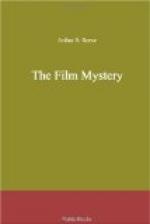“The film vaults,” Manton explained, “are at the corner of the west wing. They have to be ventilated specially, on account of the high inflammability of the celluloid composition. Since the greatest fire risk, otherwise, is the laboratory and printing departments, and next to that the studios themselves with the scenery, the heat of the lights, the wires, etc., we have located them in the most distant corner of the quadrangle. The negative, you see, represents our actual invested capital to a considerable extent. The prints wear out and frequently large sections are destroyed and have to be reprinted. Then sometimes we can reissue old subjects. All in all we guard the negative with the care a bank would give actual funds in its vaults.”
In our many visits to the Manton studios I had been struck by the scrupulous cleanliness of every part of the place. The impression of orderliness came back to me with redoubled force as we made our way around in the basement. Nothing seemed out of its proper position, although a vast amount of various material for picture making was stored here. We passed two projection rooms, one a miniature theater with quite a bit of comfort, the other small and bare for the use of directors and cutters.
Finally we saw the vaults ahead of us. The walls were concrete, matching the actual walls of the basement. There were two entrances and the doors were double, of heavy steel, arranged so that an air space would give protection in case of fire. At a roll-top desk, arranged for the use of the clerk in charge of the negatives and prints, was a young boy.
“Where’s Wagnalls?” demanded Manton.
“He went out, sir,” the boy replied, respectfully enough. “Said he would be right back and for me to watch and not to let anything get out.”
The promoter led the way into the first room. Here on all four sides and in several rows down the center, like the racks in a public library, were shelves supporting stacks of square thin metal boxes or trays with handles and tightly fitting covers. Cards were secured to the front of each, by clamps, giving the name of the picture and the number under which the film was filed. I was surprised because I expected to find everything kept in ordinary round film cans.
“These are the negatives,” Manton explained. He pulled out a box at random, opening it. “The negative is not all spliced together, the same length as the reels of positive, because the printing machines are equipped to take two-hundred-foot pieces at a time, or approximate fifths of a reel, the size of a roll of raw positive film stock. Then whenever there is a change in color, as from amber day that to blue tint for night, the negative is broken because pieces of different coloring have to go through different baths, and that also determines the size of the rolls. The prints, or positives, in the other vaults, are in reel lengths and so are kept in the round boxes in which they are shipped.”




